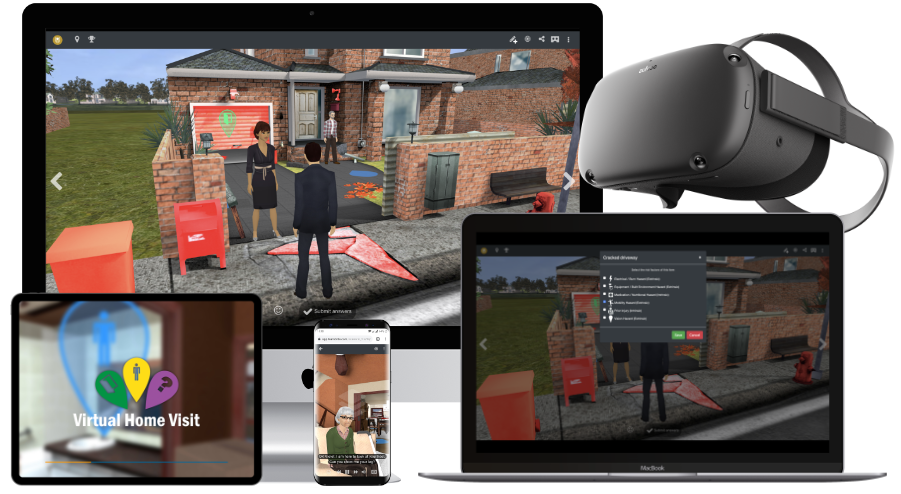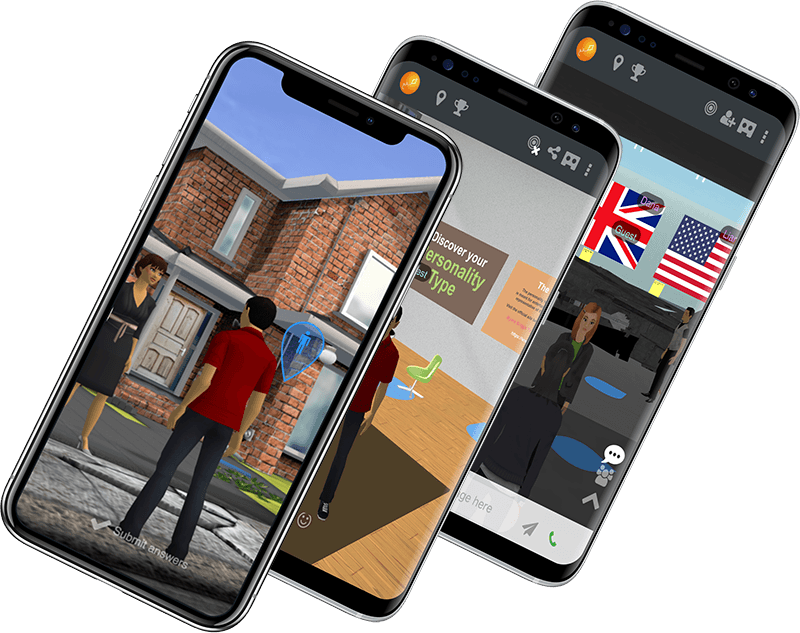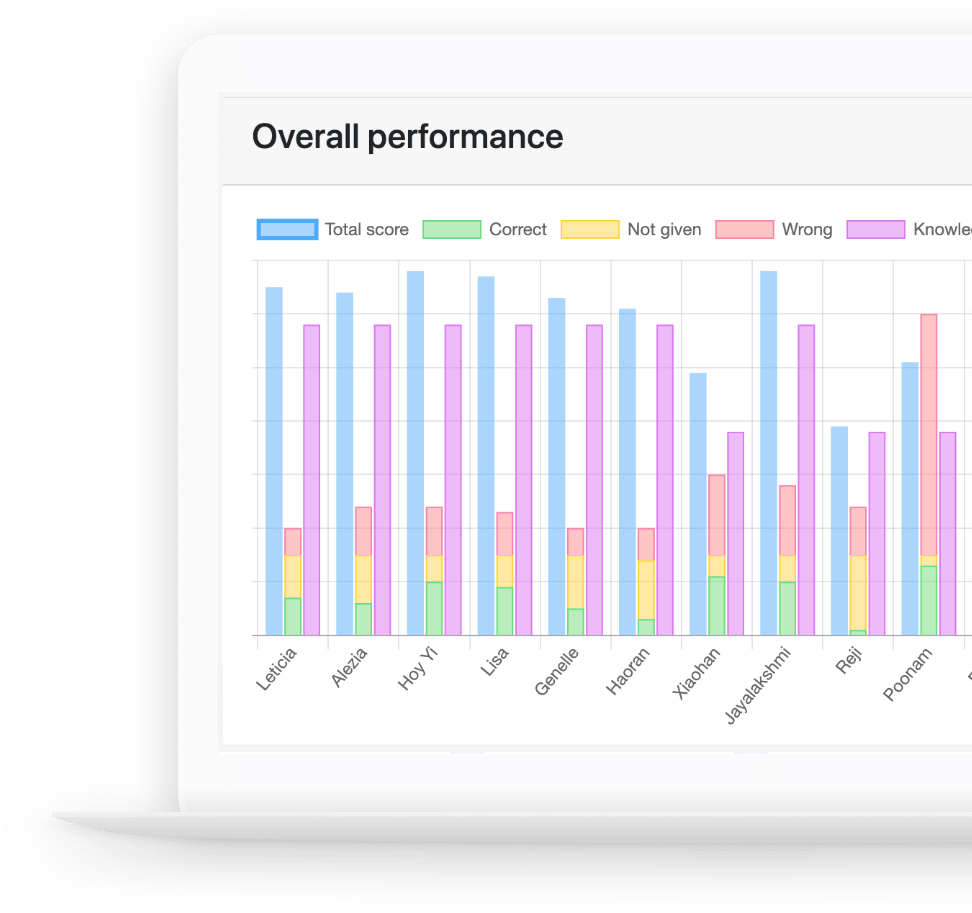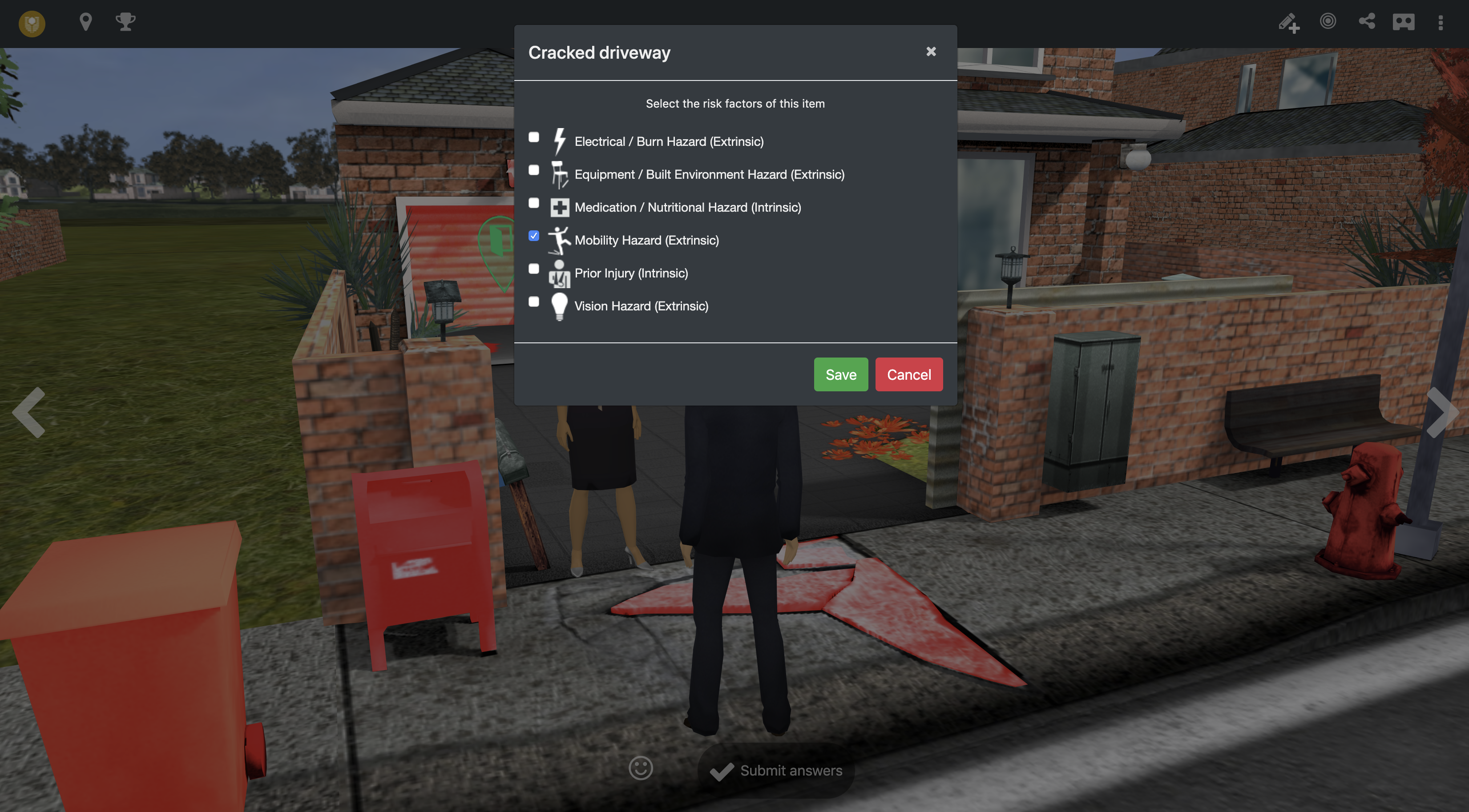Game-Based HEALTHCARE Training
Virtual Home Visit
Millennial Learning Experience
A fully-customizable training tool that gives students valuable in-the-field experience through a highly responsive simulation of a home visit. Change everything or only modify enough to make it work for you, it’s your choice. A tool created by universities, for healthcare students and professionals.

Gameplay Experience
Can you help Walter figure out if his wife Violet is going to need some extra care?
She has been falling more and more recently, and you have been called in to conduct a home visit. By talking with the characters and scouring the 4 individual zones of the house, you will identify the telltale signs of risk factors – will you understand what the most appropriate response is for each situation, or overlook something important?
- Customize the experience for your specific learning goals
- Integrate with your institution’s LMS, or use stand-alone
- See the learner’s progress with in-depth reports
- Provide real-time coaching
- Works on any device and browser, from smartphones, tablets and laptops to the latest VR/AR headsets
- No apps to install, instant delivery
A Complete Educational Platform
Powerful Analytics
What sets this training platform apart is the ability to track every behaviour and conversational choice made by the learner. In the set up phase, your institution’s learning objectives become a map for conversational elements. As a result each choice made by the learner within that framework is recorded and evaluated.
What this means is that at the end of the game, you can see how each learner behaved in terms of your own individual module. Did they make the best choices, or were their responses sub-optimal?
Fully Customisable
The game comes “out of the box” 80% complete, which avoids the cost of developing the game from the ground up. Our experienced team, completes the game to your exact needs using your learning objectives as the model.
This means there is a template and general functionality, like questioning, player analytics and gameplay standard in any version of the game. The 80% complete concept reduces your costs and provides you with an immersive learning game quickly and inexpensively.
Learning Elements
The interactive learning experience uses evidence-based best practices as they relate to game-based learning. Research has shown that games are effective for learning because they actively engage learners in the course material, as opposed to passively conveying it during a lecture, an assigned reading, or a watching a video. Research strongly suggests that the more active and engaged the learner, the more effective the learning.
When a learner makes a decision in the game, he or she receives immediate feedback either reinforcing or correcting the decision and behaviour.
Evidence-Based Approach
The result of this evidence-based approach is a tool that motivates and engages the learner while simultaneously meeting the desired behavioural and learning goals. Research indicates that the engaging elements of games make them effective tools for learning, and when properly designed and incorporated into a curriculum provide improvements in learner performance.

Fully Customisable
The Virtual Home Visit is built upon a flexible game engine and environment. This means that Violet, Walter, and their story are not the only alternatives possible.
If you want for the roles to be swapped, you can make Walter the one at risk, or you can create entirely new avatars for the learner to interact with – different people, same engaging gameplay and learning outcome.
You can “swap out” the interactive elements of a scene with others, or change the environment altogether, if the house is not what you’re looking for (coincidentally, we also have a Virtual Hospital Visit); perhaps an auditorium is what you’re looking for, or seminar room, or a gallery. Those options are available within the game with minimum costs because the underlying game engine does not change, only the “skin” or appearance of the game changes, keeping the cost low.
The Virtual Home Visit is built so that if anything is not exactly right for your learning objectives, you can change it so that the experience fits to your specific needs.
Powerful Analytics
The Virtual Home Visit tracks the learner’s responses to each interaction with a character and any action the player takes in the game. The characters can represent any person your learning objectives require.
The learner’s actions and responses to characters are presented in a dashboard for viewing by the professor or other program administrator, and can be specific to an individual or seen in aggregate. This allows managers to gain a high level view of the performance of their learners within the simulated home visit. It also allows you to track behavioural responses over time. Learners also receive a configurable report every time they complete an experience, so that they have a reference for their performance as well.
Conversation with Walter and Violet, and interactive objects, are defined at the beginning of the game. The written objectives are compared to the decisions the learners made during the game. This allows administrators as well as learners to evaluate how they prepared for the home visit and their intended outcome with the actual activities and events they conducted during the visit.

Learning Elements
The Virtual Home Visit uses evidence-based best practices as they relate to game-based learning. Research has shown that games are effective for learning because they actively engage learners in the course material as opposed to passively conveying it during a lecture, assigned readings or a watching a video (Sitzmann, 2011; Wouter et al, 2013).
When a learner makes a decision in a game, he or she receives feedback, either reinforcing or correcting the decision. The Virtual Home Visit consists of four parts designed to increase learning: first is a guided process where the learner understands how to interact with the game and is introduced to Walter, as well as getting them accustomed with observing the environment with obviously-placed interactive items.
This leads into the second scene, where the learner meets Violet and has a conversation with her about her general condition and how she is dealing with her medication, where Gina (your mentor in the game) highlights specific parts of the dialogue to the learner.

After the second scene, the learner is brought to the house’s first floor, where interactive items that pose a risk to Violet and Walter are more subtly placed, pushing the learner to observe the environment carefully. Walter and Violet will also share additional details about their situation, to help the student form an overall picture of their struggles and needs.
The experience closes with a recap by Gina, where she provides some more technical information on Violet which a learner would normally get from a colleague, or another professional (such as gait characteristics, in the case of a Physiotherapy Home Visit).
All characters in the experience can vary depending on the learning requirements of the course. The learner interacts with these characters reinforcing and practicing the skills associated with the course’s curriculum.
Each interaction leads to a branching scenario, some branches will be correct and others incorrect. Feedback guides learners to appropriate learning outcomes and reinforces the desired behaviour.
The focus on quick decision making and immediate consequences for incorrect answers provides authentic cognitive practice for the skills you want your sales representatives to possess. Each decision is scored, and at the end of every level, learner performance is compared to the ideal outcome of the process.
The third learning element comes into play when the learner reflects on the experience and how they executed their home visit. This helps the learner to focus on the experience and highlight what he or she did well and identify areas for improvement. This is accomplished through a series of summary questions.
Reflecting upon a learning experience is a highly effective methodology for achieving the desired results using game/simulation-based learning tools.
Why a home visit?
Why an entire home visit and not just a serious branching-simulation with no gameplay? The use of realistic environments is a purposeful design decision having a direct positive impact on learning. Research indicates that such interactions provide cognitive, emotional and motivational advantages for learning (Malone, 1981).
Feedback is conveyed in a safe environment with specific, but not catastrophic, consequences for failure. This means that failure and experimentation are allowed and encouraged. Humans learn from failure more than instant success. This environment allows for failure and re-engagement with the content again and again which leads to mastery.
We also know that if a simulation provides the same cognitive activities as the real-life situation, the skills are transferable to the actual in-the-field situation. The learning objectives reflect precisely the expertise useful in such situations. The different environments actually help with generalising the knowledge and creates, in the mind of the learner, a set of heuristics to deal with real-life situations rather than creating a rigid set of algorithms that are difficult to generalise.
In terms of emotional impact, an experience like this provokes vivid images related to the material being learned, thus improving the learner’s memory of the material. It also helps to break down the defences of a learner. When confronted with many such situations, a learner may feel he or she is already well versed in their subject, viewing the training process as a waste of time. A different situation helps to break down that resistance because the environment is new, novel and different. The learner doesn’t know how to deal with the new environment, which makes them more receptive, and open to exploring the learning environment (Lepper, 1988; Malone, 1981).
Curtin University, LearnBrite’s partner in creating both the Virtual Home Visit and the Virtual Hospital Visit, created a specification based on decades of teaching to physiotherapy students and knowing the situations and questions that needed to be addressed to create and assess competency.
The Virtual Home Visit has been deployed for multiple universities to more than 20 classes across a number of curricula, and both students and staff have been enthusiastic about it, with no complaints or expressions of dissatisfaction. Once they see and use the technology, students and staff alike tend to quickly agree that they have experienced something of the future of education. One student said, “the trouble with eLearning is that it is like a class with no teacher, in a virtual world, the avatar and assessment provide the feeling of a teacher present”.
As far as specific outcomes are concerned, items “hidden” in the environment were found by most players and only a small number (5%) of hidden items remained undiscovered. The “knowledge factors” were key to the outcomes, and the vast majority (92%) found all of the knowledge factors in conversations with virtual actors, proof that knowledge can be subtly hidden in a 3D environment and uncovered by users.
Games can be highly motivational. While not everyone loves to play games, a large portion of most populations likes to play them, and enjoy the opportunity to gain mastery of the game environment. Games provide an immersive learning environment because they require continual vigilance, provide constant feedback, correct incorrect activities and reinforce correct performance which eventually leads to mastery of content.
Let’s Get Started
Find out more about Fun, Engaging and Impactful Learning Experiences
References:
Sitzmann, T. (2011). A meta-analytic examination of the instructional effectiveness of computer-based simulation games. Personnel Psychology, 64(2), 489–528.
Wouters, P., van Nimwegen, C., van Oostendorp, H., & van der Spek, E. D. (2013). A meta-analysis of the cognitive and motivational effects of serious games. Journal of Educational Psychology, 105(2), 249–265.
Stefano, G. D., Gino, F., Pisano, G. & Staats, B. (2014) Learning by Thinking: How Reflection Aids Performance, Harvard Business School, Working Paper. 14-093.
Lepper, M. R. (1988) Motivational considerations in the study of instruction. Cognition and Instruction. 5(4), 289-309.
Malone, T. (1981) Toward a theory of intrinsically motivating instruction. Cognitive Science, 4. pp. 333-369.
Weisberg, D. S., Ilgazb, H., Hirsh-Pasekc, K., Golinkoffd, R., Nicolopouloue, A., Dickinsonf, D. K., 2015) Shovels and swords: How realistic and fantastical themes affect children’s word learning. Cognitive Development. Volume 35, July–September 2015, Pages 1–14.